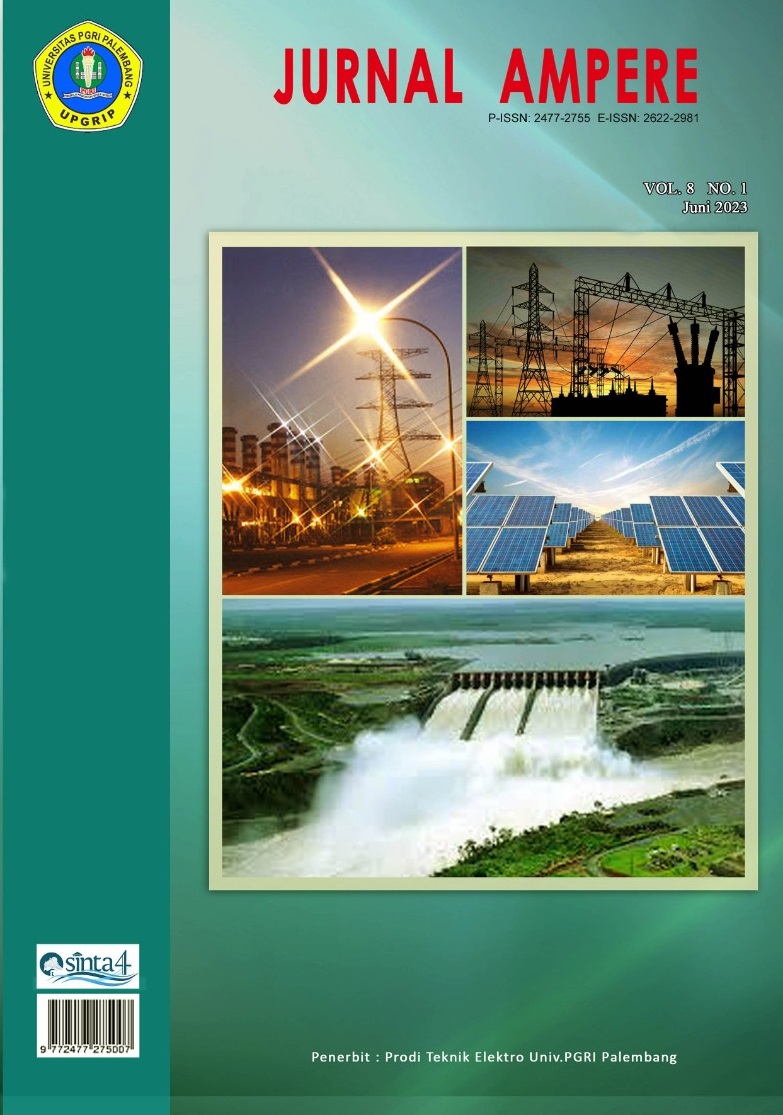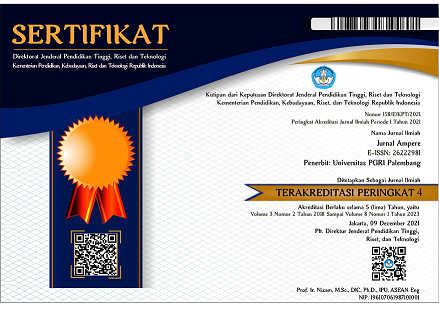Efisiensi Penggunaan Daya Listrik Di Hotel Carrissima Palembang
DOI:
https://doi.org/10.31851/ampere.v8i1.9634Keywords:
electrical energy audit, electrical energy conservation, electrical energy efficiency.Abstract
The research was conducted by assuming when the hotel room was fully occupied by guests. This research is to find out in more detail about the use of energy, especially for electrical energy at the Carrissima Hotel Palembang, to find out and implement energy saving opportunities and increase the efficiency of electricity use. The research method used is the literature method, interview method, and observation method. From the calculations carried out, the results obtained for hotel lighting, especially in the hotel lobby, cannot be said to be effective in the use of electrical energy, from the calculations obtained the intensity of lighting is 16.25 Watt/m2, while the maximum limit specified is 20 Watt/m2, while for rooms hotels, the intensity of lighting is 5.16 Watt/m2, while the maximum limit specified is 17 Watt/m2. So the intensity of the Carrissima hotel room does not have an indication of energy wastage, but it is not efficient, lastly for the use of Air Conditioning (AC) at the Carrissima hotel, from the results of these calculations based on the Energy Consumption Index (IKE), where the level of comfort and energy saving in air-conditioned buildings is 23.75 to 37.75 W/m2. The use of air conditioning at the Carrissima hotel is above the convenience of wasting energy. The highest AC power intensity is on the 2nd and 3rd floors, which is 18.33 W/m2, while the lowest intensity is on the 1st floor, which is 1.38 W/m2.References
P. A. Pratama and N. Nurdiana, “Evaluasi Kualitas Penerangan Ruang Kuliah Fakultas Teknik Universitas Pgri Palembang,” J. Ampere, vol. 5, no. 2, p. 75, 2020, doi: 10.31851/ampere.v5i2.5058.
A. Hardin, R. Gianto, T. Pontia W, and Universitas Tanjungpura Pontianak, “Studi Perencanaan Kebutuhan Instalasi Listrik di Rumah Sakit Umum Daerah dr . Rubini Mempawah,” 2016.
T. Sijabat and A. Inarto, “Pelaksanaan Penghematan Penggunaan Energi Listrik Pada Gedung Cipta Kementerian Perhubungan,” J. Bus. Adm. Econ. Entrep., vol. 3, no. 1, pp. 38–43, 2021, [Online]. Available: https://stialan.ac.id/jurnal/index.php/jbest/article/view/321/299
C. G. I. Dana, G. W. P., Arjana, I. G. D., & Partha, “Konservasi Energi Pada Gedung Kantor Sekretariat Daerah Kota Denpasar,” J. SPEKTRUM, vol. 7, no. 2, pp. 73–80, 2020, [Online]. Available: https://ojs.unud.ac.id/index.php/spektrum/article/view/61437
M. V. Fauzan and B. Husodo, “Analisis Peluang Penghematan Konsumsi Energi Pada Peralatan Listrik di Gedung Kantor PT PLN (Persero) UPT Bogor,” J. Teknol. Elektro, vol. 11, no. 1, p. 16, 2020, doi: 10.22441/jte.2020.v11i1.003.
A. D. Yuliantoro, A. A. Nugroho, and H. B. Sukoco, “Analisa Konsumsi Energi Listrik untuk Penghematan Energi Listrik di Gedung Fakultas Teknik Universitas Islam Sultan Agung,” Klaster Eng., pp. 172–179, 2019.
A. Susanti, “Analisis penghematan energi listrik dengan penggunaan solatube yang dapat digunakan pada bangunan rental office,” Imaji, vol. 9, pp. 121–130, 2020.
E. Suswitaningrum, N. Hudallah, R. D. M. Putri, and B. Sunarko, “Analisis Intensitas Konsumsi Energi Listrik dan Peluang Penghematan Energi Listrik pada Gedung C Kantor Sekretariat Daerah Kabupaten Semarang,” J. ELTIKOM, vol. 6, no. 1, pp. 26–39, 2022, doi: 10.31961/eltikom.v6i1.545.
R. U. Nuha, “Analisis Peluang Penghematan Energi Listrik Pada Unit Spinning 1 di DI PT. Delta Dunia Sandang tekstil, Demak, Jawa Tengah,” Repos. Unimus, pp. 1–14, 2013.
D. E. Putra, Y. Riswanto, and A. Komaini, “INVESTIGASI OVERLOAD TRANSFORMATOR DISTRIBUSI 20 KV DIUNIT LAYANAN PELANGGAN PANGKALAN BALAI PT. PLN (Persero),” Semin. Nas. AVoER XIII, pp. 378–383, 2021.
D. E. Putra and F. Harlian, “PERAN SUBMARINE CABLE SUMATERA BANGKA (SCSB) 150 kV DALAM MENEKAN PENGGUNAAN PLTD DI PULAU BANGKA,” J. Tek. Elektro, vol. 11, no. 2, pp. 18–23, 2021, doi: 10.36546/jte.v11i2.489.
Downloads
Published
How to Cite
Issue
Section
License
Copyright (c) 2023 Daeny Septi Yansuri, Dian Eka Putra, Subianto Subianto, Rio Anggara

This work is licensed under a Creative Commons Attribution-ShareAlike 4.0 International License.

Jurnal Ampere is licensed under a Creative Commons Attribution-ShareAlike 4.0 International License.
Authors who publish with this journal agree to the following terms:
- Authors retain copyright and grant the journal right of first publication with the work simultaneously licensed under a Creative Commons Attribution License that allows others to share the work with an acknowledgement of the work's authorship and initial publication in this journal.
- Authors are able to enter into separate, additional contractual arrangements for the non-exclusive distribution of the journal's published version of the work (e.g., post it to an institutional repository or publish it in a book), with an acknowledgement of its initial publication in this journal.
- Authors are permitted and encouraged to post their work online (e.g., in institutional repositories or on their website) prior to and during the submission process, as it can lead to productive exchanges, as well as earlier and greater citation of published work.






